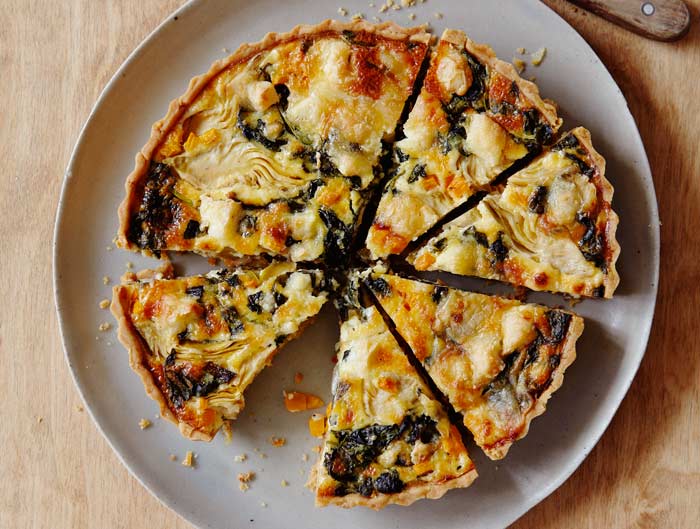When mixing up the milk and eggs for the custard here, we add tomato purée and whisk it in; this gives a tomato flavour running all the way through. Different, impressive and easy.
You can add lots of different vegetables to a quiche. Some things you can get away with uncooked: peas and tomatoes, for example, can be thrown straight in as they will cook in the heat of the egg mix. Others will have to be cooked first, such as broccoli, which is quite hard so would need blanching for a few minutes first in boiling water. We use cream cheese in this recipe, but feel free to change that to ricotta or cottage cheese, according to your mood or what you have in the fridge. The recipe asks for a 23cm diameter, 2.5cm deep fluted flan ring with a removable base; if you don’t have one, use the nearest thing, then treat yourself to one some time.
There are so many variations to a quiche; the permutations are endless and entirely up to you. However, try adding a pinch of mustard or some dried herbs to the pastry. Or how about substituting the whipping cream with sour cream?
SERVES 8
175g plain flour, plus more to dust
100g unsalted butter, chopped
1 egg yolk, plus 4 whole eggs
sea salt and freshly ground black pepper
200ml whole milk
200ml whipping cream
70g tomato purée
sunflower oil, for the flan ring
80g frozen peas, defrosted
80g frozen broad beans, defrosted, or you can use fresh if you wish (this is the storecupboard version)
80g cherry tomatoes, halved
125g soft cream cheese
Put the flour in a blender or food processor with the butter, egg yolk and seasoning, then pulse until the mix comes together and forms a dough. Or you can rub the butter in with your fingers and then mix in the egg yolk. Let the pastry rest for 10 minutes
Meanwhile, prepare the filling. In a bowl, whisk the 4 eggs well, then mix in the milk, cream and tomato purée and season well.
Preheat the oven to 180°C/fan 160°C/gas mark 4.
Next, lightly flour a worktop and roll out the pastry so it is a little larger than the flan ring, to allow for the sides of the quiche. Brush a 23cm diameter, 2.5cm deep fluted flan ring with oil. To make life easier, place the rolling pin at the edge of the rolled-out sheet closest to you. Carefully lift the edge over the pin, then very gently roll the pin so the pastry rolls itself around the pin, being careful not to press it down. Place it over the flan ring, then do the reverse roll so the pastry gently falls into place. If you already know that, just ignore the last bit. Make sure the pastry fits snugly into the corners.
Using a pair of scissors, trim off the excess but make sure you leave it a little proud, maybe 5mm, to allow for shrinkage. Line the case with greaseproof paper, fill with baking beans if you have them, if not add handfuls of lentils, then bake for 15 minutes. Remove the beans and paper and bake for another 4 or 5 minutes to crisp up.
Allow the case to cool, then scatter the peas, beans and halved tomatoes evenly around the base. Now, be near your stove when you add the rest of the filling: there’s little worse than having to walk across the kitchen balancing a dribbling quiche. Now add the milk and egg mix and finish by adding blobs of the cream cheese; just scatter them on top – some will sink and some will stay on top which will give a nice rustic look.
Slide the quiche on to the middle shelf of the oven and bake for 25 minutes until the filling is softly set.
When cooked, remove from the oven. You may be tempted to have a slice, but let it rest for 5 minutes, as it is very difficult to cut when hot. Serve warm or cold.



